The mexican sea turtles are important for their ecological role within marine and coastal ecosystems, contributing to the health and conservation of coral reefs, sea grass areas, estuaries and sandy beaches (Bouchard and Bjorndal, 2000). World wide, and since a long time ago, these species have been used to obtain a number of products (including meat, eggs, skin and tortoiseshell), which, according to the most recent assessment by the International Union for the Conservation of Nature (IUCN, 2008), includes all known species under different risk categories. The main human activities that threaten sea turtles include habitat degradation in nesting and feeding grounds, incidental fisheries, illegal nest looting and killing of females laying eggs in beaches (PNUMA, 2004; Traffic, 2004).
Mexico is the country with the largest number of sea-turtle species worldwide. Seven of the eight species known at a world level – if the black turtle is regarded as a separate species- nest in Mexican beaches, both in the Pacific and in the Golf of Mexico and Caribbean littorals: loggerhead turtle (Caretta caretta), white or green turtle (Chelonia mydas), black turtle (Chelonia agassizzi), hawksbill turtle (Eretmochelys imbricata), Kemp’s ridley (Lepidochelys kempii), olive ridley (Lepidochelys olivacea) and leatherback turtle (Dermochelys coriacea). Two of them, Kemp’s ridley and black sea turtle, nest exclusively in Mexican beaches (Map a).
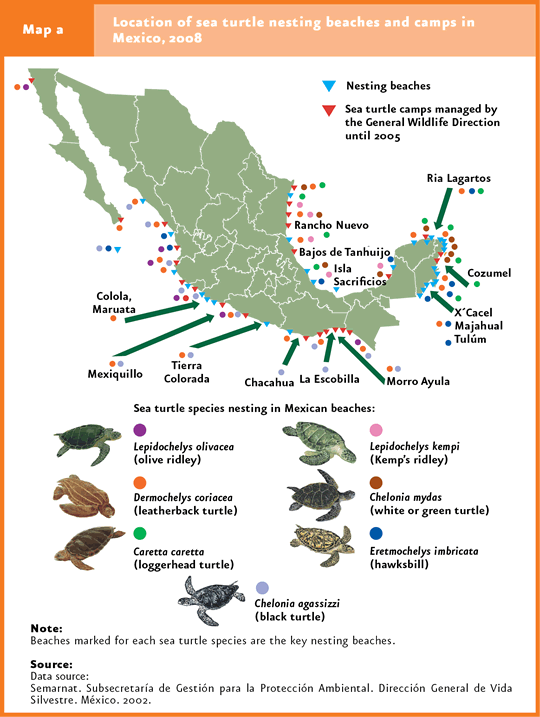
In Mexico, sea turtle protection and conservation takes place mainly in the so-called turtle camps (Cuadro D3_R_BIODIV04_05), within the National Program for the Sea Turtle Protection, Conservation, Research and Management which, starting in the year 2005, was transferred from the General Wildlife Direction (DGVS in Spanish) to the General Direction of Regional Operations at the National Commission of Protected Natural Areas (Conanp in Spanish). Today, 27 turtle camps are operating, denominated Sea Turtle Protection and Conservation Centers (CPCTM in Spanish), 9 along the Golf of Mexico (Tamaulipas, Veracruz and Campeche), 3 in the Caribbean Coast (Yucatan and Quintana Roo) and 15 along the Pacific littoral (Sinaloa, Nayarit, Jalisco, Colima, Michoacan, Guerrero, Oaxaca and Chiapas), including the Mexican Turtle Center, located in Mazunte, Oaxaca (Figure a). In Los Cabos, Baja California, there is a turtle camp also depending on Conanp which, although not being a turtle protection center as such, carries out protection activities in different local nesting beaches.
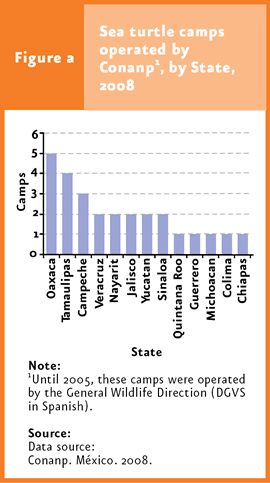
In these camps, the species with the highest attention is the olive ridley (15 camps), followed by leatherback (11) and white (10). Turtles with the lower degree of attention are hawkbill and black turtles (three camps each) and loggerhead (one camp; Figure b). In addition to CPCTM, there are 174 additional turtle camps, both permanent and temporary, which also undertake protection and conservation activities, operated under cooperation agreements by NGOs, state government offices and research centers.
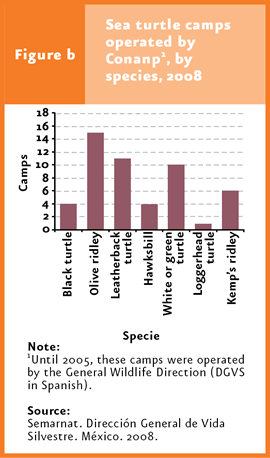
Some of the measures giving an idea on sea-turtle protection and conservation efforts by the government are the average number of protected nests, eggs seeded and hatchlings produced for the different sea turtle species nesting in the country. Considering all the species nesting in Mexican beaches, the number of hatchlings released between 1996 and 2001 in turtle camps remains relatively unchanged, despite slight variations, averaging about 553 thousand hatchlings per year (IB 6.4.2-4). An important rise was recorded from 2003, peaking in 2006 with 49.5 million hatchlings released (Figure c). To note, this rise resulted mostly from the fact that data were gathered from a larger number of camps rather than from an unprecedented success in sea turtle management.
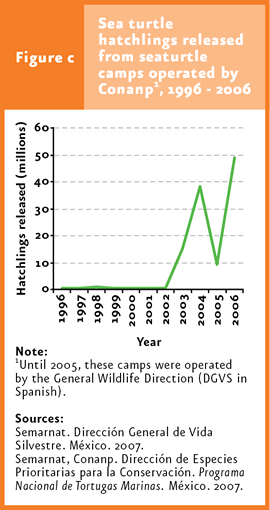
Another strategy that has directly or indirectly contributed to protect sea turtles is the creation of Protected Natural Areas (ANP in Spanish). Although some of them have been created specifically for protecting these animals, others have included turtles as a parallel group within their goals. As of 2008, 24 federal ANPs included sea-turtle protection among their objectives (Figure d;IB 6.4.2-7).
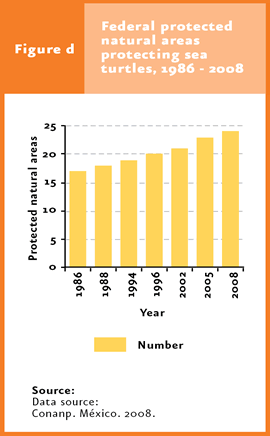
References:
Bouchard, S. y K. A. Bjorndal. Sea turtles as biological transporters of nutrients and energy from marine to terrestrial ecosystems. Ecology 81: 2314–2330. 2000.
Conanp. Tortugas marinas. 2008. Available at: www.conanp.gob.mx/tortuga_marina.html Consulted on: 20-01-2009.
PNUMA. Las tortugas del Caribe, próximas a extinción, alerta estudio. 2004. Available at: www.pnuma.org/informacion/noticias/2004-11/29nov04e.doc Consulted on: 01-12-2008.
Traffic. Priority Species: Marine Turtles. 2004.
IUCN. The IUCN Red list of threatened species. The IUCN Species Survival Commission. 2008.Available at: www.iucnredlist.org/ Consulted on: 01-12-2008.
|